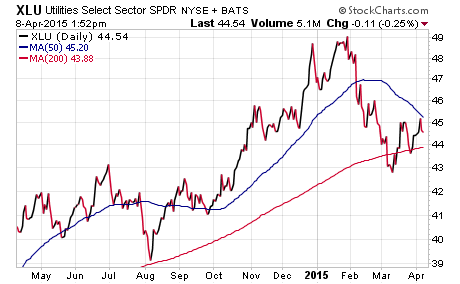Utility stocks were one of the surprising sectors of 2014 as these conservative companies’ raced higher on the back of falling interest rates. This sector is known as one of the more defensive-minded areas of the market alongside health care and consumer staples companies.
Last year, the sector benchmark Utility Select Sector SPDR (XLU) gained an astounding 28.74 percent as long-dated Treasuries and other interest-rate sensitive asset classes soared. However, the first quarter of 2015 saw a spike in interest rates that utilities have been unable to recover from.
XLU tracks 32 large-cap companies engaged in electric, gas, and other power generating businesses. The largest holdings in XLU include: Duke Energy Corp (DUK), NextEra Energy Inc (NEE), and Dominion Resources Inc (D).
XLU was the worst major S&P sector to start the year with a loss of 5.17 percent through March 31. Much of that decline can be traced to a jump in the CBOE 10-Year Treasury Note Yield (TNX) from a low of 1.65 percent to a high of 2.25 percent in just a few short weeks.
XLU was then unable to recover despite interest rates tailing off to end the quarter substantially lower.
This price action may be the result of sellers taking gains on an overbought area of the market and looking to redeploy capital in more advantageous areas. It also may signal a shift in confidence away from utilities as the looming threat of a Fed rate hike has a significant chance of impacting this sector in a negative way.
One advantage of the selloff has been the concomitant increase in yield on XLU. This fund now sports a 30-day SEC yield of 3.39 percent, which is the highest of any of the major sectors.
Not surprisingly, utility stocks are heavily represented in high dividend paying indexes such as the iShares Select Dividend ETF (DVY) and PowerShares S&P 500 High Dividend Portfolio (SPHD). These funds also underperformed their peers in the first quarter because of their higher exposure to the utility sector.
Like the energy sector, utility stocks have shown some weakness to macro-economic factors beyond their control. Nevertheless, those same characteristics make them some of the most attractive stocks for income investors to own for high dividends.
© 2025 Benzinga.com. Benzinga does not provide investment advice. All rights reserved.
Trade confidently with insights and alerts from analyst ratings, free reports and breaking news that affects the stocks you care about.

